|
Copy of the Articles of Confederation
Original Copy of the Articles of Confederation
The
First Constitution was the Articles of Confederation
Introduction
The Articles of Confederation served as the written document that established the functions of the national
government of the United States after it declared independence from Great Britain. It established a weak central government
that mostly, but not entirely, prevented the individual states from conducting their own foreign diplomacy. The Articles of
Confederation were adopted by the Continental Congress on November 15, 1777, and served as the nation's first constitution
from 1781 to 1789, when the present-day Constitution went into effect.
History
On June 11, 1776, the Second Continental Congress appointed three committees
in response to the Lee Resolution.* One of these committees, created to determine the form of a confederation of the colonies,
was composed of one representative from each colony with John Dickinson, a delegate from Delaware, as the principal writer.
The Dickinson Draft of the Articles of Confederation named the Confederation
"the United States of America," provided for a Congress with representation based on population, and gave to the national
government all powers not designated to the states. After considerable debate and alteration, the Articles of Confederation
were adopted by Congress on November 15, 1777. In this "first constitution of the United States" each state retained "every
Power...which is not by this confederation expressly delegated to the United States," and each state had one vote in Congress.
Instead of forming a strong national government, the states entered into "...a firm league of friendship with each other..."
Ratification by all 13 states was necessary to set the Confederation into
motion. Because of disputes over representation, voting, and the western lands claimed by some states, ratification was delayed
until Maryland ratified on March 1, 1781, and the Congress of the Confederation came into being. This document is the engrossed
and corrected version that was adopted on November 15, 1777.
*The Lee Resolution, also known as the resolution of independence, was a
three–part resolve by the Second Continental Congress on June 7, 1776, to declare the United Colonies rightfully independent
of the British Empire, to establish a plan for ensuing American foreign relations, and to establish a plan of a confederation
to unite them officially. The resolution is named for Richard Henry Lee of Virginia who proposed it to Congress.
| Articles of Confederation (page 1) |
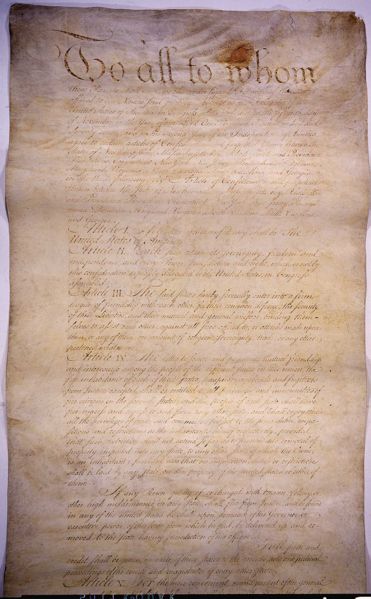
|
| Articles of Confederation (page 1) |
Original Copy of the U.S. Articles of Confederation, page 1
| Articles of Confederation (page 2) |
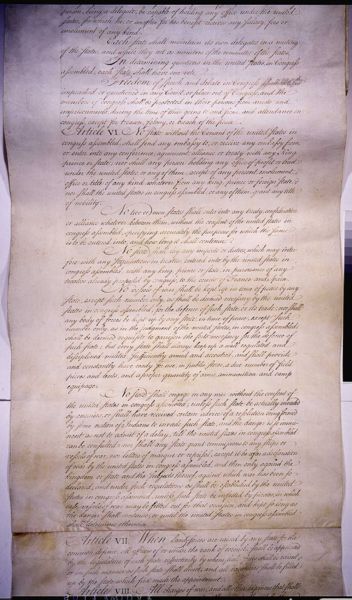
|
| Articles of Confederation (page 2) |
Original Copy of the U.S. Articles of Confederation, page 2
| Articles of Confederation (page 3) |
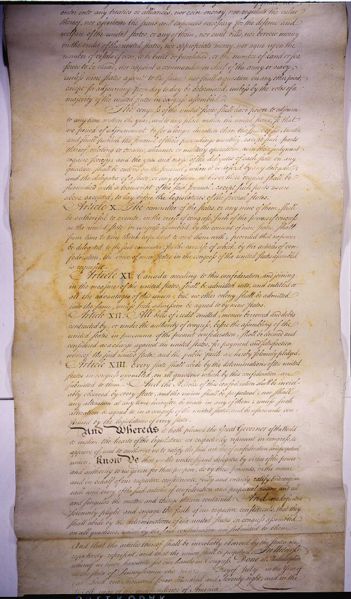
|
| Articles of Confederation (page 3) |
Original Copy of the U.S. Articles of Confederation, page 3
| Articles of Confederation (page 4) |
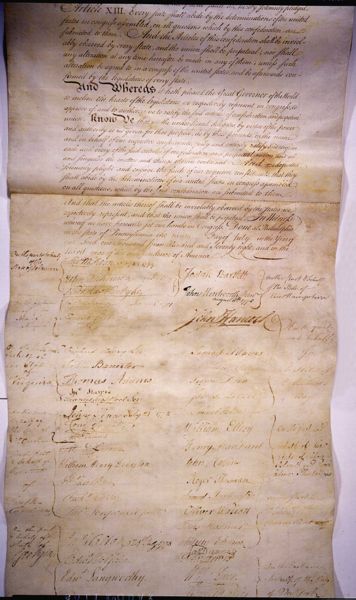
|
| Articles of Confederation (page 4) |
Original Copy of the U.S. Articles of Confederation, page 4
| Articles of Confederation (page 5) |
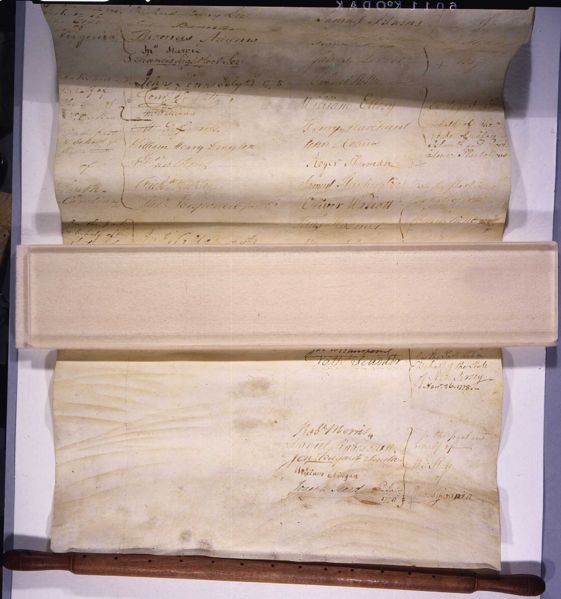
|
| Articles of Confederation (page 5) |
Original Copy of the U.S. Articles of Confederation, page 5
Source: Articles of Confederation: Engrossed and corrected copy of the Articles of Confederation, showing
amendments adopted, November 15, 1777, Papers of the Continental Congress, 1774-1789; Records of the Continental and Confederation
Congresses and the Constitutional Convention, 1774-1789, Record Group 360; National Archives.
Recommended Reading: The Articles of Confederation: An
Interpretation of the Social-Constitutional History of the American Revolution, 1774-1781 (Paperback).
Review: I don't suppose one in ten Americans realize
there was a first constitution of the United States
before there was "the" Constitution of the United States. Merrill Jensen is the definitive
historian of that period - up to 1789 when the present Constitution took effect - and this book is one of several of his covering
the topic. Reading
of this period would do much to remind Americans that the debate over the nature of American government has been going on
since 1776. The debate concerns "weak" central government (the Articles of Confederation) vs. "strong" central government
(the Constitution). The Federalists (favoring the Constitution) won politically, but their victory did not settle the argument.
Continued below...
Any American
presidential or congressional election campaign brings out the same themes sounded 200 years ago as the Constitution faced
ratification. In any event, Jensen does much to rehabilitate the history of the Confederation, clarify the agruments, and
takes care to note the remarkable accomplishments of the Confederation congress. His writing style is very accessible and
the book is a quick read.
Recommended Reading: The
Constitution of the United States of America, with the Bill of Rights and all of the Amendments; The
Declaration of Independence; and the Articles of Confederation, by Thomas Jefferson (Author), Second Continental Congress (Author), Constitutional Convention (Author).
Description: Collected in one affordable volume are the most important documents of the United
States of America: The Constitution of the United
States of America, with the Bill of Rights and all of the Amendments; The Declaration of
Independence; and the Articles of Confederation. These three documents are the basis for our entire way of life. Every citizen
should have a copy.
Recommended Viewing: John Adams (HBO
Miniseries) (2008) (501 minutes). Description: Based on David McCullough's bestselling
biography, the HBO miniseries John Adams is the furthest thing from a starry-eyed look at America's
founding fathers and the brutal path to independence. Adams (Paul Giamatti), second president of the United States, is portrayed as a skilled orator and principled attorney whose preference
for justice over anti-English passions earns enemies. But he also gains the esteem of the first national government of the
United States, i.e., the Continental Congress, which seeks non-firebrands capable of making a reasoned if powerful case for
America's break from England's monarchy. The first thing one notices about John Adams' dramatizations of congress' proceedings,
and the fervent pro-independence violence in the streets of Boston and elsewhere, is that America's roots don't look pretty
or idealized here. Some horrendous things happen in the name of protest, driving Adams to
push the cause of independence in a legitimate effort to get on with a revolutionary war under the command of George Washington.
But the process isn't easy: not every one of the 13 colonies-turned-states is ready to incur the wrath of England, and behind-the-scenes negotiations prove as much
a part of 18th century congressional sessions as they do today. Continued below...
Besides this
peek into a less-romanticized version of the past, John Adams is also a story of the man himself. Adams' frustration at being
forgotten or overlooked at critical junctures of America's early development--sent abroad for years instead of helping
to draft the U.S. constitution--is detailed.
So is his dismay that the truth of what actually transpired leading to the signing of the Declaration of Independence has
been slowly forgotten and replaced by a rosier myth. But above all, John Adams is the story of two key ties: Adams'
54-year marriage to Abigail Adams (Laura Linney), every bit her husband's intellectual equal and anchor, and his difficult,
almost symbiotic relationship with Thomas Jefferson (Stephen Dillane) over decades. Giamatti, of course, has to carry much
of the drama, and if he doesn't always seem quite believable in the series' first half, he becomes increasingly excellent
at the point where an aging Adams becomes bitter over his place in history. Linney is marvelous,
as is Dillane, Sarah Polley as daughter Nabby, Danny Huston as cousin Samuel Adams, and above all Tom Wilkinson as a complex
but indispensable Ben Franklin.
Recommended Reading:
John Adams, by David McCullough (Simon & Schuster). From Publishers
Weekly: Here a preeminent master of narrative history takes on the most fascinating of our founders to create a benchmark
for all Adams biographers. With a keen eye for telling detail and a master storyteller's
instinct for human interest, McCullough (Truman; Mornings on Horseback) resurrects the great Federalist (1735-1826), revealing
in particular his restrained, sometimes off-putting disposition, as well as his political guile. The events McCullough recounts
are well-known, but with his astute marshaling of facts, the author surpasses previous biographers in depicting Adams's years
at Harvard, his early public life in Boston and his role in
the first Continental Congress, where he helped shape the philosophical basis for the Revolution. McCullough also makes vivid
Adams's actions in the second Congress, during which he was the first to propose George Washington
to command the new Continental Army. Continued below...
Later on, we
see Adams bickering with Tom Paine's plan for government as suggested in Common Sense, helping push through the draft for
the Declaration of Independence penned by his longtime friend and frequent rival, Thomas Jefferson, and serving as commissioner
to France and envoy to the Court of St. James's. The author is likewise brilliant
in portraying Adams's complex relationship with Jefferson, who ousted him from the White
House in 1800 and with whom he would share a remarkable death date 26 years later: July 4, 1826, 50 years to the day after
the signing of the Declaration. (June) Forecast: Joseph Ellis has shown us the Founding Fathers can be bestsellers, and S&S
knows it has a winner: first printing is 350,000 copies, and McCullough will go on a 15-city tour; both Book-of-the-Month
Club and the History Book Club have taken this book as a selection.
Recommended
Reading: Founding Brothers: The Revolutionary Generation. Review: In retrospect, it seems as if the American Revolution was inevitable. But was it?
In Founding Brothers, Joseph J. Ellis reveals that many of those truths we hold to be self-evident were actually fiercely
contested in the early days of the republic. Ellis focuses on six crucial moments in the life of the new nation, including
a secret dinner at which the seat of the nation's capital was determined--in exchange for support of Hamilton's
financial plan; Washington's precedent-setting Farewell
Address; and the Hamilton and Burr duel. Most interesting, perhaps, is the debate (still dividing scholars today) over the
meaning of the Revolution. Continued below...
In a fascinating
chapter on the renewed friendship between John Adams and Thomas Jefferson at the end of their lives, Ellis points out the
fundamental differences between the Republicans, who saw the Revolution as a liberating act and hold the Declaration of Independence
most sacred, and the Federalists, who saw the revolution as a step in the building of American nationhood and hold the Constitution
most dear. Throughout the text, Ellis explains the personal, face-to-face nature of early American politics--and notes that
the members of the revolutionary generation were conscious of the fact that they were establishing precedents on which future
generations would rely. In Founding Brothers, Ellis (whose American Sphinx won the National Book Award for nonfiction in 1997)
has written an elegant and engaging narrative, sure to become a classic. Highly recommended.
Recommended
Viewing: Founding Brothers
(A&E) (200 minutes). Description: The political
wrangles of a fledgling country may sound dull compared to the drama of a war, but the early history of the United
States only gets more fascinating as the Revolutionary War is left behind. Founding Brothers,
a documentary from the History Channel, examines the struggle to not only establish democracy, but to give it the economic
strength and governmental structure that will allow it to survive and thrive. George Washington grappled not only with politics,
but with questions of style and propriety--how should a president, as opposed to a king, behave? Understanding the conflicts
between Alexander Hamilton, John Adams, and Thomas Jefferson will illuminate ideas that have shaped the government of the
U.S. ever since. Continued below…
Founding Brothers
provides a wealth of portraits and illustrations from the time, as well as discreet dramatizations, that bring the rise of
party politics to life, humanizing these historical figures with tales of the scandals and squabbles they faced as well as
their political achievements. An excellent introduction to the roots of the American experiment, and a bracing illustration
of what Jefferson
meant when he said of the presidency, "No man will bring out of that office the reputation which carried him into it."
Recommended Viewing: Founding Fathers (A&E)
(200 minutes). Description: The four programs from the History Channel in this set profile America's Founding Fathers, noting right at the outset they were a "mismatched
group of quarrelsome aristocrats, merchants, and lawyers." The story of how these disparate characters fomented rebellion
in the colonies, formed the Continental Congress, fought the Revolutionary War, and wrote the Constitution is told by noted
historians, and the production is enhanced with beautifully photographed reenactments as well as intelligent use of period
paintings and engravings. The story begins with Samuel Adams and John Hancock in Boston,
whose protests against British taxation led to the Boston Tea Party. Moving on to the Continental Congress meeting in Philadelphia, the brilliant delegates from the South, particularly George
Washington and Thomas Jefferson, appear on the scene, and the story is told of how an improbable cohesion between the colonies
began. Continued below…
Other main
characters, including Benjamin Franklin and John Adams, appear in turn, and each of the major participants is portrayed in
a biographical profile. How these men all came to act together, despite the stark differences in their backgrounds and temperaments,
becomes the main thread of the story. They were all quite human, as the historians who appear in interviews remind us. Some
of them drank too much, some had illegitimate children, some owned slaves, and some could hardly get along with anyone. Yet
these men with complicated private lives worked together and performed heroically. This is an intelligently rendered and captivating
look at the men who formed the American nation.

|

